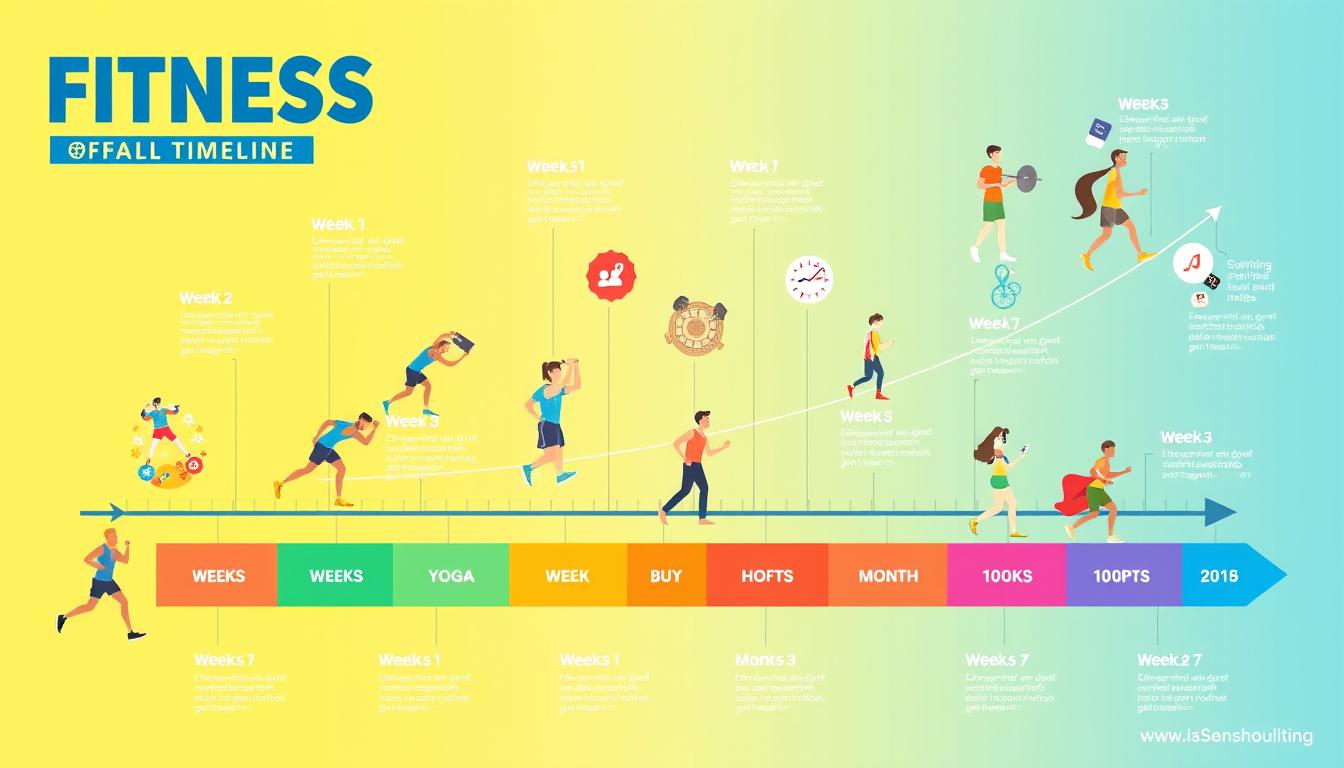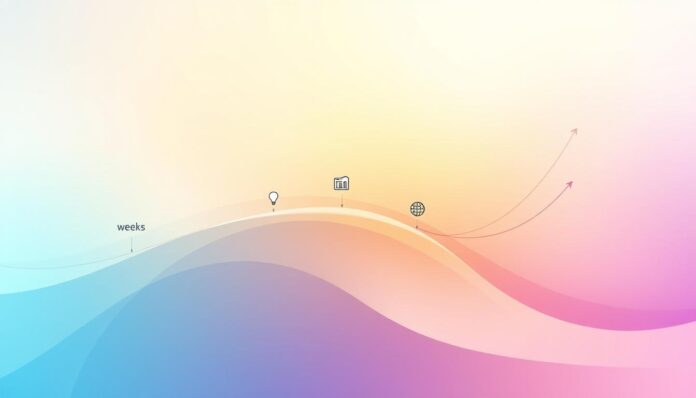“An abstract visualization of a goal achievement timeline, featuring a gradient of colours representing different time scales from weeks to months, with symbolic icons representing milestones along a curved path, incorporating flowing arrows and subtle geometric shapes to indicate progress and movement.”
Personal growth takes time and patience. Tracking progress helps keep you motivated on your journey.
Goals aren’t achieved overnight. Different objectives need different timeframes, from weeks to months.
Success comes from clear plans and dedication. Innovative strategies break big goals into smaller steps.
This lets you check your progress quickly. You can change your plan if needed.
Tracking small wins keeps you excited. It shows you’re moving forward.
Knowing timelines helps you make smart choices. It stops you from giving up too soon.
Significant results come from steady work. Your timeline depends on your situation and goals.
Understanding the Timeline for Results
Setting long-term goals requires a brilliant plan. People often think significant changes happen faster than they do.
Break big goals into smaller, doable steps. This makes the journey easier and more exciting.
Patience is key in any growth process. Real change takes time.
Focus on steady effort, not quick fixes. Each small step brings you closer to your goal.
Tracking progress is vital for big goals. Make a visual map to stay on track.
This turns big dreams into clear, doable steps. It makes goals feel within reach.
Set accurate expectations to stay motivated. Know that significant changes take time.
Enjoy the journey and celebrate small wins. Stay committed to your growth path.
Mix patience with thoughtful planning for better results. Short-term goals guide you to bigger dreams.
Factors Influencing Timeframes for Results
Progress isn’t the same for everyone. Genetic makeup, fitness level, and metabolism affect how fast goals are achieved.
Environmental factors also impact progress tracking. Support systems and daily routines can influence the speed of improvement.
Consistency is key to seeing results. Tiny, repeated actions create meaningful change over time.
Personal factors like age and sleep quality affect progress. Understanding these helps set realistic goals.
Tracking progress needs patience. Focus on your growth, not comparing yourself to others.
Setting Realistic Expectations: Weeks to Months
Goal-setting needs a brilliant plan for personal and work wins. People often think progress happens faster than it does.
Tracking progress keeps you going. Break big goals into small steps you can check weekly.
Be ready to change your plans. Real-life problems might pop up and need new ideas.
Goals take different times to reach. Short-term goals may show results in 4-6 weeks.
Bigger goals might need 3-12 months of hard work. Knowing this helps you stay on track.
Check your progress often. Look at what’s working every few weeks.
Fix what needs to get better. This keeps you moving towards your goals.
Common Areas of Improvement and Their Timelines
A visually engaging infographic illustration depicting a timeline of fitness goals and skill acquisition, featuring vibrant icons representing various exercises, sports skills, and milestones, arranged along a gradual upward curve, with different segments showcasing timeframes from weeks to months and diverse representations of people engaging in fitness activities like running, weightlifting, yoga, and team sports, set against a bright and motivating background.
People chase different fitness goals. Physical changes need steady work.
Muscles can grow in 4-8 weeks. Significant strength gains show up in 12-16 weeks.
It takes about 66 days to make a new habit stick.
Learning a new physical skill takes 6-12 weeks. Complex thinking skills need months of practice.
Experts say patience is key. Tracking progress keeps people motivated.
Fitness goals are about minor, steady improvements.
Mental skills follow similar patterns. Beginners see changes in 4-6 weeks.
Mastery needs long-term effort and innovative practice.
These timelines help set fair hopes. Results vary based on effort and genes.
The secret is to keep going and enjoy learning.

Tips for Staying Motivated Through the Process
Track your progress strategically to stay motivated during your transformation journey. Break big goals into smaller, achievable milestones for frequent recognition.
Use a progress journal to document your weekly achievements visually. Log improvements with apps or spreadsheets to reinforce your commitment.
Celebrate milestones with rewards that align with your goals. For example, new workout gear or a spa day can mark fitness targets.
Develop a growth mindset to view challenges as learning opportunities. See setbacks as temporary obstacles, not permanent roadblocks.
Surround yourself with supportive people who understand your goals. They can encourage you during tough times.
FAQ
How long does it typically take to see results in different areas of personal development?
Results can vary widely. Most people notice changes between 4 to 12 weeks, depending on their goal.
Fitness improvements might show in 6-8 weeks. Habit formation often takes 2-3 months of steady effort.
Why do some goals take longer to achieve than others?
Goals have unique challenges and complexity. Factors like genetics, starting point, and environment affect progress speed.
Losing weight might show faster results than learning a new language.
How can I stay motivated when progress feels slow?
Track small milestones and celebrate tiny wins. Break big goals into smaller, manageable steps.
Use tools to see your progress. Stay patient and keep a growth mindset.
What are some realistic timelines for common personal improvement goals?
Fitness goals might show results in 6-8 weeks. Habit formation typically takes 2-3 months.
Essential skill learning can take 3-6 months. Significant lifestyle changes often take 6-12 months.
How important is consistency in achieving goals?
Consistency is key. Most big results come from steady effort over time.
Small, regular actions can lead to significant changes. Create habits you can stick to.
Can individual differences impact goal achievement timelines?
Yes! Age, genes, fitness level, and motivation affect how fast you see results.
What takes one person 8 weeks might take another 12. Focus on your journey.
How can I set realistic expectations for my goals?
Research typical timelines for your goal. Ask experts in that field for advice.
Break big goals into smaller steps. Be ready to change your plan as needed.
You can also read more : Mastering Your Job Search with LoopCV: The Ultimate Job Hunting Tool



